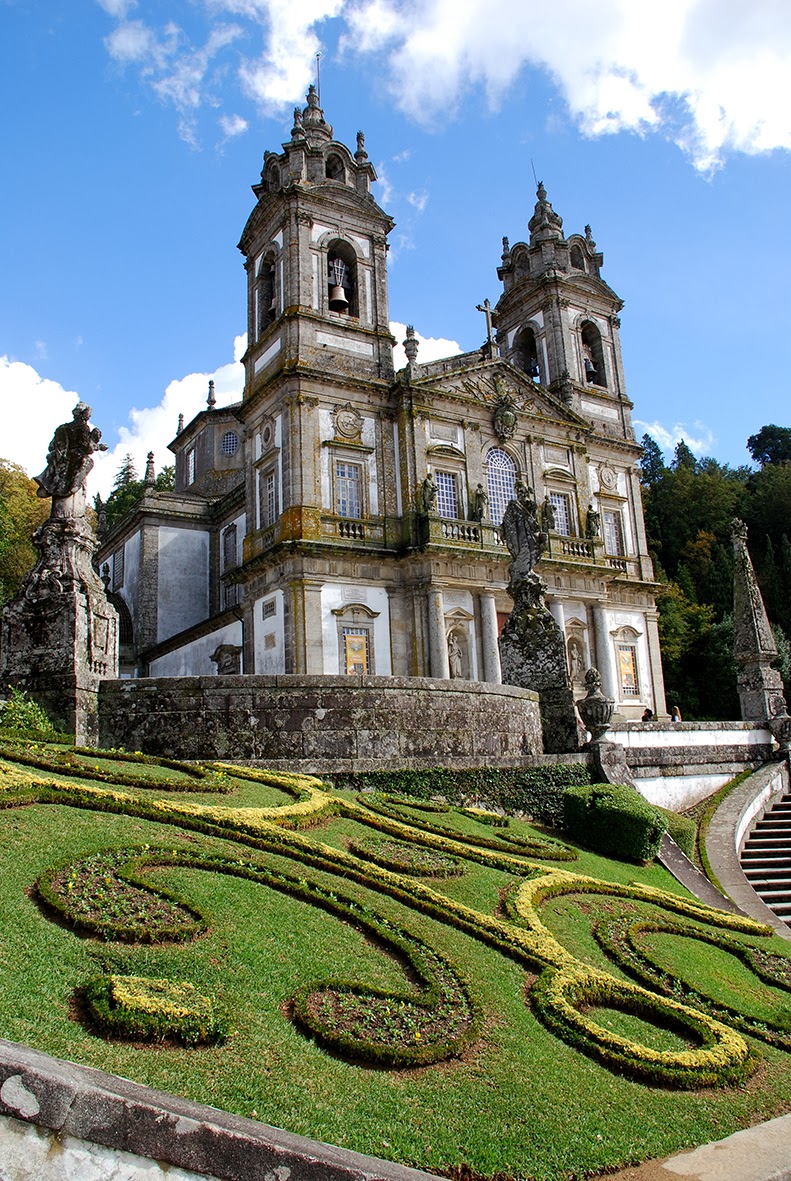Since antiquity, hilltops have been places of worship in Europe, and it is likely that this particular hilltop was one such place. However, it wasn't until 1373 that a chapel first appeared on the hill. The chapel was later rebuilt in the 15th and 16th centuries. And in 1629, a pilgrimage church dedicated to Bom Jesús was built.
 |
| The church with the iconic zig-zag Baroque staircase in front |
The current Sanctuary dates from 1722 when it was commissioned by Rodrigo de Moura Teles, the then-Archbishop of Braga (t. 1704-1728), whose coat of arms can be seen over the gateway at the bottom of the stairs. Under his direction two segments of the famous zigzag Baroque stairway were built. At the top of these was a Baroque church designed by the architect Manuel Pinto Vilalobos.
Some time later, around 1781, Gaspar de Bragança, the new Archbishop of Braga (t. 1758-1789) had the church demolished to make way for a third segment of stairs, also in a zigzag pattern, and a new church. Started in 1784 and built by Carlos Amarante, the new church was one of the first neoclassical style churches in Portugal. It was completed and consecrated in 1834.
Some time later, around 1781, Gaspar de Bragança, the new Archbishop of Braga (t. 1758-1789) had the church demolished to make way for a third segment of stairs, also in a zigzag pattern, and a new church. Started in 1784 and built by Carlos Amarante, the new church was one of the first neoclassical style churches in Portugal. It was completed and consecrated in 1834.
 |
| The 18th century neoclassical church |
 |
| View of Braga from the gardens |
Without doubt, the most impressive part of the Sanctuary is the Via Sacra do Bom Jesús (The Sacred Way). A Baroque staircase that took 89 years to build, it rises several hundred metres.
Traditionally pilgrims climbed the 116-metre long (381 feet) staircase on their knees while contemplating the Stations of the Cross, which have been reconstructed with life-size statues. After this comes Escadaria dos Cinco Sentidos (Stairway of the Five Senses), each one represented by a different fountain, and then Escadaria das Três Virtudes (Stairway of the Three Virtues), which has chapels and fountains symbolising faith, hope and charity. Together these stairways represent the spiritual journey that believers must take in order to accede to salvation.
 |
| One of the many statues |
 |
| Aesthetically-pleasing lines |
 |
| The fountain representing charity |
 |
| The view from further down the staircase |
Somewhat unsurprisingly, I didn't climb the steps on my knees. Instead, I took the water-powered funicular. Built in 1882, the funicular linked the city of Braga to the hill. It was the first funicular to be built in the Iberian peninsula and it's still in use today. Having ascended by funicular, I opted to walk down the stairs – although again, not on my knees – and, when I turned around, I was rewarded by some fantastic views...
 |
| The 'Sacred Way' in all its glory |
No comments:
Post a Comment